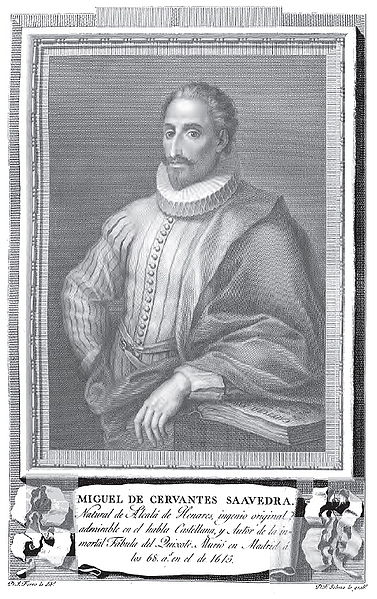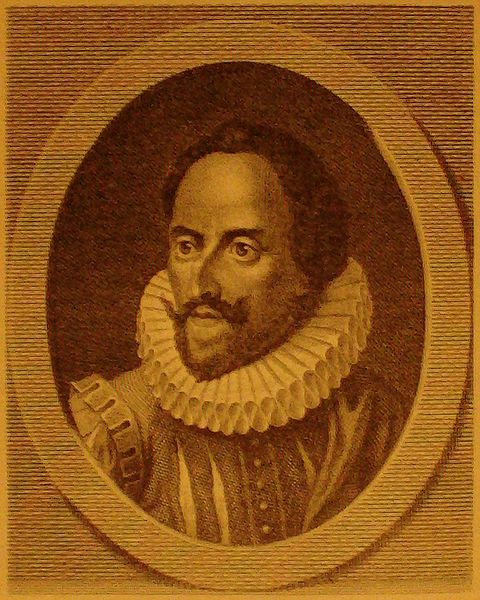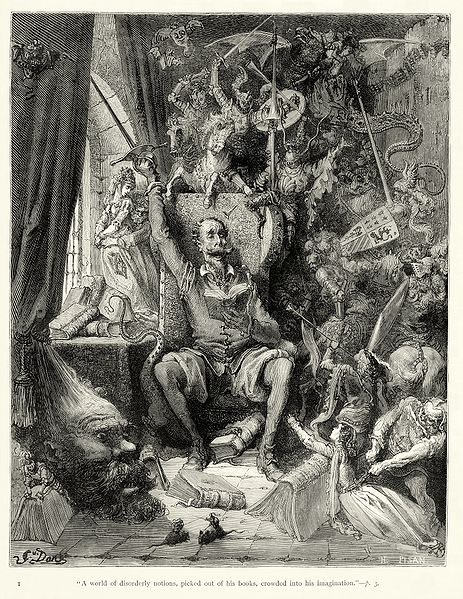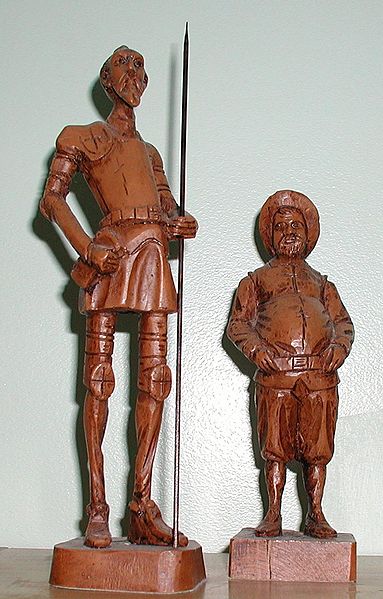<Back to Index>
- Mathematician Jacques Charles François Sturm, 1803
- Novelist Miguel de Cervantes Saavedra, 1547
- Vice Admiral of the White Horatio Nelson, 1758
PAGE SPONSOR
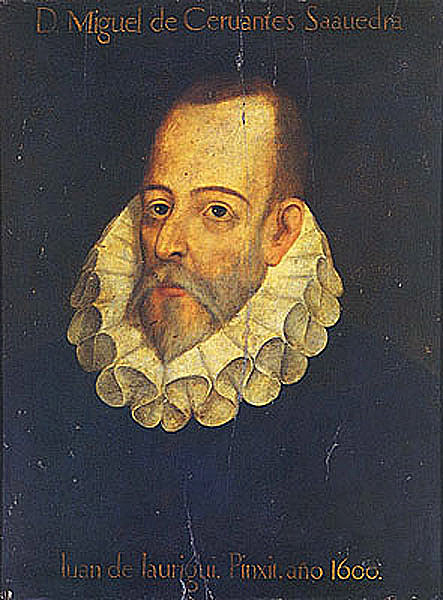
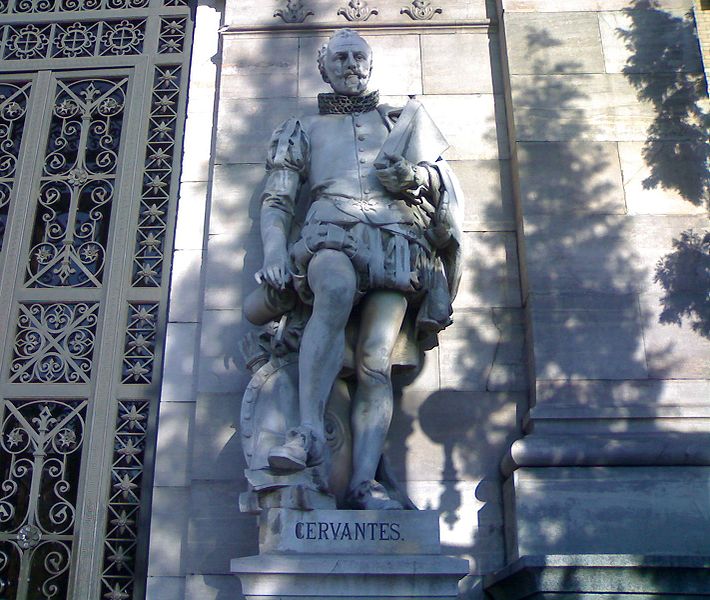
Miguel de Cervantes Saavedra (29 September 1547 – 23 April 1616) was a Spanish novelist, poet, and playwright. His magnum opus Don Quixote, often considered the first modern novel, is a classic of Western literature, and is regarded amongst the best works of fiction ever written. His work is often considered amongst the most important works in all of Western literature. His influence on the Spanish language has been so great that Spanish is often called la lengua de Cervantes, Spanish for the language of Cervantes. He has been dubbed El Príncipe de los Ingenios – The Prince of Wits.
It is assumed that Miguel de Cervantes was born in Alcalá de Henares, Spain. The exact date of his birth is not known, but it is probable that he was born on 29 September, the feast day of Saint Michael the Archangel, given the tradition to name a child with the name of the feast day of his birth. Cervantes was baptized in Alcalá de Henares on October 9, 1547, at the parish church of Santa Maria la Mayor. The baptismal act read:
Sunday, the ninth day of the month of October, the year of our Lord one thousand five hundred forty and seven years, Miguel was baptized, son of Rodrigo Cervantes and his wife doña Leonor. Baptized by the reverend sir Bartolomé Serrano, priest of Our Lady. Witnesses, Baltasar Vázquez, Sacristan, and I, who baptized him and signed this in my name.— Bachiller Serrano
His father was Rodrigo de Cervantes, a surgeon of Cordoban descent.
At the time, a surgeon was not a medical doctor, but a lesser medical
practitioner with no exact equivalent in modern English speaking
countries. His paternal grandfather, Juan de Cervantes, was an
influential lawyer who held several administrative positions. His uncle
was mayor of Cabra for many years. Little is known of his mother Leonor
de Cortinas, except that she was a native of Arganda del Rey.
His siblings were Andrés (1543), Andrea (1544), Luisa (1546),
Rodrigo (1550), Magdalena (1554) and Juan (known solely because he is
mentioned in his father's will). In 1569, Cervantes moved to Italy, where he served as a valet to Giulio Acquaviva, a wealthy priest who was elevated to cardinal the next year. By then, Cervantes had enlisted as a soldier in a Spanish Navy infantry regiment and continued his military life until 1575, when he was captured by Algerian corsairs. He was then released on ransom from his captors by his parents and the Trinitarians, a Catholic religious order. He subsequently returned to his family in Madrid. In 1585, Cervantes published a pastoral novel named La Galatea. Because of financial problems, Cervantes worked as a purveyor for the Spanish Armada, and later as a tax collector. In 1597, discrepancies in his accounts of three years previous landed him in the Crown Jail of Seville. In 1605, he was in Valladolid, just when the immediate success of the first part of his Don Quixote,
published in Madrid, signaled his return to the literary world. In
1607, he settled in Madrid, where he lived and worked until his death.
During the last nine years of his life, Cervantes solidified his
reputation as a writer; he published the Exemplary Novels (Novelas ejemplares) in 1613, the Journey to Parnassus (Viaje al Parnaso) in 1614, and in 1615, the Ocho comedias y ocho entremeses and the second part of Don Quixote. Carlos Fuentes noted that, "Cervantes leaves open the pages of a book where the reader knows himself to be written." The reasons that forced Cervantes to leave Castile remain
uncertain. Whether he was a "student" of the same name, a
"sword wielding fugitive from justice", or fleeing from a royal warrant
of arrest, for having wounded a certain Antonio de Sigura in a duel, is
another mystery. In any event, in going to Italy, Cervantes was doing what many young Spaniards of the time did to further their careers in one way or another. Rome would reveal to the young artist its ecclesiastic pomp, ritual, and majesty. In a city teeming with ruins Cervantes could focus his attention on Renaissance art, architecture, and poetry (knowledge of Italian literature is
readily discernible in his own productions) and on rediscovering
antiquity. He could find in the ancients "a powerful impetus to revive
the contemporary world in light of its accomplishments". Thus,
Cervantes' continuing desire for Italy, as revealed in his later works,
was in part a desire for a return to an earlier period of the
Renaissance. By 1570, Cervantes had enlisted as a soldier in a regiment of the Spanish naval elite corps, Infantería de Marina, stationed in Naples, then a possession of the Spanish crown. He was there for about a year
before he saw active service. In September 1571 Cervantes sailed on
board the Marquesa, part of the galley fleet of the Holy League (a coalition of the Pope, Spain, the Republic of Venice, the Republic of Genoa, the Duchy of Savoy, the Knights Hospitaller based in Malta, and others, under the command of King Philip II's illegitimate half brother, John of Austria) that defeated the Ottoman fleet on October 7 in the Gulf of Lepanto near Corinth, at great cost to both sides. Though taken down with fever, Cervantes
refused to stay below, and begged to be allowed to take part in the
battle, saying that he would rather die for his God and his king than
keep under cover. He fought bravely on board a vessel, and received
three gunshot wounds – two in the chest, and one which rendered
his left arm useless. In Journey to Parnassus he
was to say that he "had lost the movement of the left hand for the
glory of the right" (he was thinking of the success of the first part of Don Quixote).
Cervantes always looked back on his conduct in the battle with pride:
he believed that he had taken part in an event that would shape the
course of European history. After the Battle of Lepanto Cervantes
remained in hospital for around six months, before his wounds were
sufficiently healed to allow his joining the colors again. From 1572 to 1575, based mainly in Naples, he continued his soldier's life: he participated in expeditions to Corfu and Navarino, and saw the fall of Tunis and La Goletta to theTurks in 1574. On 6 or 7 September 1575 Cervantes set sail on the galley Sol from Naples to Barcelona, with letters of commendation to the king from the duke de Sessa. On the morning of September 26, as the Sol approached the Catalan coast, it was attacked by Algerian corsairs under the command of the redoubtable Arnaut Mami, an Albanian renegade and terror of the narrow seas at that time. After significant resistance, in which the captain and many crew members were killed, the surviving passengers were taken to Algiers as captives. After five years spent as a slave in Algiers, and four unsuccessful escape attempts, he was ransomed by his parents and the Trinitarians and
returned to his family in Madrid. Not surprisingly, this period of
Cervantes' life supplied subject matter for several of his literary
works, notably the Captive's tale in Don Quixote and the two plays set in Algiers – El Trato de Argel (The Treaty of Algiers) and Los Baños de Argel (The Baths of Algiers) – as well as episodes in a number of other writings, although never in straight autobiographical form. In Esquivias (Province of Toledo), on 12 December 1584, he married the much younger Catalina de Salazar y Palacios (Toledo, Esquivias –
31 October 1626), daughter of Fernando de Salazar y Vozmediano and
Catalina de Palacios. Her uncle Alonso de Quesada y Salazar is said to
have inspired the character of Don Quixote. During the next 20 years
Cervantes led a nomadic existence, working as a purchasing agent for the Spanish Armada and
as a tax collector. He suffered a bankruptcy and was imprisoned at
least twice (1597 and 1602) for irregularities in his accounts. Between
1596 and 1600, he lived primarily in Seville. In 1606, Cervantes settled in Madrid, where he remained for the rest of his life. In 1585, Cervantes published his first major work, La Galatea, a pastoral romance, at the same time that some of his plays, now lost – except for El Trato de Argel (wherein he dealt with the life of Christian slaves in Algiers) and El Cerco de Numancia – were playing on the stages of Madrid. La Galatea received
little contemporary notice; and Cervantes never wrote the continuation
for it, which he repeatedly promised to do. Cervantes next turned his
attention to drama, hoping to derive an income from that source, but
the plays which he composed failed to achieve their purpose. Aside from
his plays, his most ambitious work in verse was Viaje del Parnaso (1614) –
an allegory which consisted largely of a rather tedious though
good-natured review of contemporary poets. Cervantes himself realized
that he was deficient in poetic talent. If a remark which Cervantes himself makes in the prologue of Don Quixote is
to be taken literally, the idea of the work (though hardly the writing
of its First Part, as some have maintained) occurred to him in prison at Argamasilla de Alba in
La Mancha. Cervantes' idea was to give a picture of real life and
manners, and to express himself in clear language. The intrusion of
everyday speech into a literary context was acclaimed by the reading
public. The author stayed poor until 1605, when the first part of Don Quixote appeared. Although it did not make Cervantes rich, it brought him international appreciation as a man of letters. The popularity of Don Quixote led to the publication of an unauthorized continuation of it by an unknown writer, who masqueraded under the name of Alonso Fernández de Avellaneda. Cervantes produced his own continuation, or Second Part, of Don Quixote, which made its appearance in 1615. He had promised the publication of a second part in 1613 in the foreword to the Novelas Ejemplares (Exemplary Novels), a year before the publication of Avellanda's book. Don Quixote has
been regarded chiefly as a novel of purpose. It is stated again and
again that he wrote it in order to satirize the [romance of
chavalry] and to challenge the popularity of a form of literature that
had been a favorite of the general public for more than a century. Don Quixote certainly
reveals much narrative power, considerable humor, a mastery of
dialogue, and a forceful style. Of the two parts written by Cervantes,
perhaps the first is the more popular with the general public –
containing the famous episodes of the tilting at windmills, the attack
on the flock of sheep, the vigil in the courtyard of the inn, and the
episode with the barber and the shaving basin. The second part shows
more constructive insight, better delineation of character, improved
style, and more realism and probability in its action. In 1613, he published a collection of tales, the Exemplary Novels, some of which had been written earlier. On the whole, the Exemplary Novels are worthy of the fame of Cervantes. The picaroon strain, already made familiar in Spain through the Picaresque novels of Lazarillo de Tormes and his successors, appears in one or another of them, especially in the Rinconete y Cortadillo. In 1614, he published the Viaje del Parnaso and in 1615, the Eight Comedies and Eight New Interludes. At the same time, Cervantes continued working on Los Trabajos de Persiles y Sigismunda, a novel of adventurous travel, completed just before his death, and appearing posthumously in January 1617. Cervantes died in Madrid on April 23, 1616. In honor of the date on which both Miguel de Cervantes and William Shakespeare died, UNESCO established April 23 as the International Day of the Book. (Shakespeare
and Cervantes, however, did not actually die on the same day, as the
April 23 date for Shakespeare is Julian calendar (Old Style) and the
April 23 date for Cervantes is Gregorian calendar (New Style) as those
were the calendars in effect in England and in Spain, respectively, at
that time. The Gregorian calendar was then ten days ahead of the
Julian.) The Encyclopedia Hispanica claims that the date widely quoted as Cervantes' date of death, namely April 23, is actually the date on his tombstone,
which, in accordance with the traditions of the time, would be the date
of his burial, rather than the date of his death. If this is true,
then, according to Hispanica, it means that Cervantes probably died on April 22 and was buried on April 23, but the true date of his death is unknown. Of
his burial-place nothing is known, except that he was buried, in
accordance with his will, in the neighboring convent of Trinitarian
nuns. Isabel de Saavedra, Cervantes' daughter, was supposedly a member
of this convent. A few years afterwards the nuns moved to another
convent and carried their dead with them. Whether the remains of
Cervantes were included in the removal or not no one knows, and the
clue to their final resting place is now lost.

